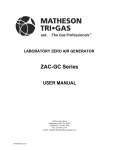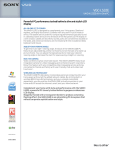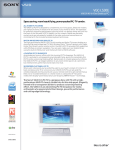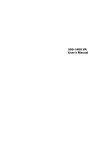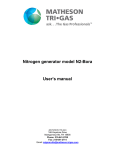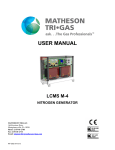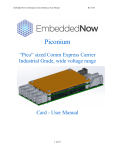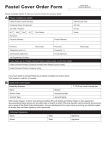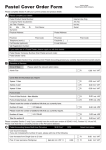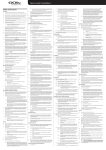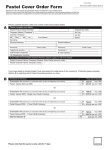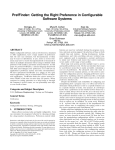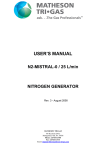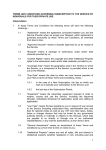Download LeakHunter Plus 8066 User Manual
Transcript
LeakHunter Plus 8066 User Manual LeakHunter Plus LTR A1 B1 REVISION Release for Prod Revise Spares List DATE 11-02-95 05-23-96 BY CJC BT INT-0124-XX DISCLAIMER Matheson Gas Products makes no representations or warranties with respect to the contents or use of this manual and specifically disclaims any express or implied warranties of merchantability or fitness for any particular purpose. Further Matheson reserves the right to make changes to the instrument and this manual, at any time, without obligation to notify any person or entity of such revisions or changes. LIMITED WARRANTY This equipment is sold by Matheson Gas Products (Matheson) under the warranties set forth in the following paragraphs. Such warranties are extended only with respect to the purchase of this equipment directly from Matheson or Matheson's Authorized Agent as new merchandise and are extended to the first Buyer thereof other for than the purpose of resale. For a period of one year from date of original delivery (ninety days in corrosive service) to Buyer or to Buyer's order, this equipment, is warranted to be free from functional defects in materials and workmanship and to conform to the description of this equipment contained in this manual and any accompanying labels and/or inserts, provided that this equipment is properly operated under the conditions of normal use and that regular and periodic maintenance and service is performed or replacements are made in accordance with the instructions provided. Expendable parts of this equipment are similarly warranted to be free from functional defects in materials and workmanship and to conform to the description of this equipment contained in this manual and any accompanying labels and/or inserts. The foregoing warranties shall not apply if the equipment has been repaired other than by Matheson or a service facility designated by Matheson, or if this equipment has not been operated and maintained in accordance with written instructions provided by Matheson, or has been altered by anyone other than Matheson, or if the equipment has been subject to abuse, misuse, negligence or accident. Matheson's sole and exclusive obligation and the Buyer's sole and exclusive remedy under the above warranties is limited to repairing or replacing, free of charge, at Matheson's sole discretion, the equipment or part which is telephonically reported to be a problem to the local Matheson Branch Location, and which if so advised, is returned with a written statement of the observed deficiency, not later than seven days after the expiration of the applicable warranty, to the Matheson Gas Equipment Technology Center during normal business hours, transportation charges prepaid, and which, upon examination, is found to comply with the above warranties. Return trip transportation charges for the equipment or part shall be paid by the Buyer. MATHESON SHALL NOT BE OTHERWISE LIABLE FOR ANY DAMAGES INCLUDING BUT NOT LIMITED TO INCIDENTAL DAMAGES, CONSEQUENTIAL DAMAGES, OR SPECIAL DAMAGES, WHETHER SUCH DAMAGES RESULT FROM NEGLIGENCE, BREACH OF WARRANTY OR OTHERWISE. THERE ARE NO EXPRESS OR IMPLIED WARRANTIES WHICH EXTEND BEYOND THE WARRANTIES HEREINABOVE SET FORTH. MATHESON MAKES NO WARRANTY OF MERCHANTABILITY OR FITNESS FOR A PARTICULAR PURPOSE WITH RESPECT TO THE EQUIPMENT OR PARTS THEREOF. ACCEPTANCE OF THE EQUIPMENT BY THE FINAL BUYER INDICATES THE FINAL BUYER'S ACCEPTANCE OF ALL WARRANTIES AND LIMITATIONS SET FORTH ABOVE. Matheson Gas Products 166 Keystone Drive Montgomeryville, PA 18936 Ph. 215-641-2700 Fax 215-641-2714 INT-0124-XX 2 1.0 Introduction The LeakHunter Plus, Model 8066, is a hand held instrument typically used for detecting leaks in gas plumbing joints, and for testing the integrity of sealed units using a tracer gas. The magnitude of the leak is indicated by a bargraph display and an audible tick. Operation can be one, or two handed. The audible tick and a peak hold mode allows operation in awkward situations where the display is not visible. The peak hold mode causes the display to retain the highest reading detected. A nozzle is available for measuring large leaks by allowing the sample to be thirty times greater than with it off. An extended probe is supplied to facilitate access in difficult applications. An internal pump draws leakage gas and surrounding air in through the nozzle, then over the sensor that measures the thermal conductivity of the gas/air mixture. Thermal conductivity is defined as the rate of flow of heat through a medium. The gas/air mixture escapes from the instrument via four holes in its base. The LeakHunter Plus will indicate when a gas is present that has a thermal conductivity that differs from that of the ambient air on which it was zeroed. The instrument is normally zeroed in ambient air comprising a mixture of approximately 78% nitrogen and 21% oxygen. Hence, the instrument is not very sensitive to nitrogen or oxygen, but has a high sensitivity to helium and hydrogen since these have very different thermal conductivities from air. (See Section 8.) A gas may have a higher or lower thermal conductivity than air, and thus produce a positive or negative reading on the display. The instrument has four gas group ranges to target the gases having thermal conductivities that differ from air by different degrees. The instrument can indicate a leak in terms of concentration (ppm), or flow rate (cfm, ml/sec or ml/min). Readings are approximateand relative; the instrument is intended to aid in the precise location of a leak, and to give an indication of its severity. Flow rate readings assume that all the leaking gas passes through the probe: If some of the leaking gas escapes to the surrounding air, without passing through the instrument, the flow reading will be inaccurate to that extent. The unit is battery operated using standard or rechargeable battery cells. A power transformer is supplied for operating the unit from a 120VAC source. INT-0124-XX 3 Section 1 Unpacking LeakHunter Plus 8066 Extended probe AC Power adaptor & Cable battery charger Probe Clip Battery Range extension nozzle Figure 1 case contents Check that the following are supplied: • Range extension nozzle • *Probe clip and template • AC power adapter and battery charger • Battery • User manual • Cleaning wipe • Extended probe * The clip attaches permanently to the rear of the instrument. The probe slides into the clip so that one-handed operation is possible. Since the clip is quite large, you may decide not to install it if you intend to carry the instrument around in your pocket. INT-0124-XX 4 1.1 Attaching the probe clip A template is supplied to permit accurate positioning of the clip. Note that the adhesive on the clip is permanent, and once fitted, the clip is not easily removed. 1. Clean the rear of the box using the wipe supplied. Allow the surface to dry. 2. Position the template onto the rear of the instrument as shown in Figure 1. 3. Peel off the paper that protects the adhesive on the back of the clip. Rear of case Probe clip Assembly aid Figure 2 Probe clip template 4. Carefully position the clip in the position defined by the template and press it firmly in position. 5. Remove the template. 6. The probe can now be clipped to the instrument for one-handed operation. Pass the cable through the slot in the clip, then push the probe into the clip until it clicks into place. 7. To remove the probe, simply pull it forward out of the clip. INT-0124-XX 5 Section 2 Specification Maximum sensitivity under ideal conditions He 1x10-5, R12 8x10-5, CH4 1x10-4, C02 1x10-4 (ml/s) Detector Dual cell micro volume thermal conductivity cell Detects All gases with a thermal conductivity different from air Display units cm3/s, cm3/min, cu ft/min, ppm - selectable Functions Peak hold, Zero, Calibrate, Gas type, nozzle type Response time Approximately 1s Recovery time Approximately 1s Audio Signal proportional to leak rate. Diagnostics Battery low indication Detector cell failure alarm Operating time 4 hours maximum from rechargeable battery Battery One PP3 dry cell or rechargeable Mains supply 115V 50/60 Hz Carrying case size 3.5 x 10 x 14 (inches) (8.9 x 25.4 x 35.6 cm) Weight: Hand unit Total, inc. case 440 g (1 lb) 1.5 kg (3.3 lb) INT-0124-XX 6 Section 3 Controls and Indicators Pictures of the display and controls are shown at the rear of this manual. 3.1 Bargraph and exponent The bargraph and exponent indicate the leak rate in terms of the selected units. For example, a leak rate of +6 x10-4 ml/sec would appear as shown opposite. 3.2 Zero Operating this button sets the detected value, the display, and audible signal to zero. 3.3 Units Press ZERO and GAS GROUP together to step through the available units of measure to set the one desired. The correspondence between leak rate settings depends on the sample flow rate. If accurate measurements are required the instrument should be calibrated in the same mode as it will be used. 3.4 Peak hold Press PEAK HOLD to select and display the Peak Hold symbol on the screen. In this mode, the instrument shows the highest positive, or negative, value measured since the mode was entered. Press PEAK HOLD again to exit this mode. The audible leak indication remains unaffected. 3.5 Gas group button Use this button to see and select the required gas group. Upon pressing the button, the display will blank except for the Leak Rate Exponent which shows the current gas group. After two seconds, the displayed number will start to cycle through the gas groups 1 to 4. To keep the current gas group, press the button again immediately. To select a different gas group, press the button again when the required group number is visible. The gas groups, and thermal conductivities, are listed in Section 8. INT-0124-XX 7 3.6 Power button Use this button to turn the instrument on and off. 3.7 Nozzle present A range extension nozzle is available for monitoring high leak rates. The nozzle diverts 97% of the air input away from the sensor so that a much larger flow can be handled. After attaching the nozzle, press PEAK HOLD and GAS GROUP together so that the Nozzle Present symbol appears on the display. Where a flow rate is being indicated, the instrument adjusts the reading to adjust for the fact that 97% of the flow is bypassing the sensor. Concentration (ppm) values will not be affected. Upon removing the nozzle, press PEAK HOLD and GAS GROUP again to remove the Nozzle Present symbol. The same operations should be carried out when attaching, or removing, the extended probe supplied as part of the 8066. 3.8 Battery low This symbol becomes visible when the battery is low. Refer to Section 6. Section 4 Operation 4.1 Starting up and switching off Press the POWER button to turn on the instrument. During the first six seconds (approx.), the instrument performs a start-up and test sequence. After this, the instrument can be switched off by pressing the POWER button again. If the battery voltage is below the operating threshold, the instrument will switch off automatically. If no buttons are pressed for 15 minutes, the instrument will turn itself off. An audible warning will occur for 5 seconds before it turns off. Pressing any button during this period will keep the instrument on for another 15 minutes. INT-0124-XX 8 4.2 Measurement To use the instrument: 1. If necessary, press ZERO and GAS GROUP repeatedly to select the required units. See Section 3.3. 2. Use GAS GROUP to check/select the appropriate gas group. See Sections 3.5 and 8. 3. Press ZERO to zero the meter reading on the instrument, well away from the leak. 4. Use the instrument to trace the leak. The bargraph display and exponent, along with the audible ticks, indicate the extent of the leak. For awkward situations, the instrument can be used one-handed with peak hold selected. See Section 3.4. 4.3 Sensitivity setting To contend with various leak rates, the instrument has three decade ranges: 1, 10 and 100. This is particularly pertinent to the audible ticks: The dynamic range of the audible ticks is only 100:1, and will saturate in the presence of high gas concentrations unless the sensitivity is reduced. At switch-on, or if the units are changed, the instrument defaults to the most sensitive range. To change the sensitivity range, press and hold ZERO then press PEAK HOLD. You will see the displayed exponent change with the change of sensitivity. For instance, with ml/sec units, successive exponents will be -5 (most sensitive range),-4 and -3, for a zeroed reading. Press ZERO and PEAK HOLD again to select the desired sensitivity. For flow measurements, you can use the x30 nozzle as an alternative to reducing the sensitivity level. The x30 nozzle allows the instrument to cope with higher leakage flow rates without reducing the dynamic range of the instrument. 4.4 x30 nozzle This nozzle allows the measurement of flow rates with high volume leaks that are beyond the normal range of the instrument. The nozzle diverts approximately 97% of the gas/air mixture away from the sensor so that the instrument can handle approximately 30 times the normal maximum leak rate. The instrument must be told that the nozzle is installed so that leak rate readings are adjusted accordingly (i.e. 30 times the actual measured rate). 1. Attach the nozzle over the normal nozzle and locate it securely on the housing. 2. Press the PEAK HOLD and GAS GROUP buttons together to make the Nozzle Present symbol appear on the display. INT-0124-XX 9 The extended probe has a similar effect to the x30 nozzle. Note that the response and cleardown times are increased when the extended probe is fitted. To restore the instrument to its normal state, remove the nozzle and press PEAK HOLD and GAS GROUP to remove the Nozzle Present symbol. 4.5 Calibration The instrument is not intended for accurate measurement of leaks; for normal leak tracing, no calibration is necessary. The instrument is factory calibrated to a helium leak. However, it is possible to improve the accuracy of the instrument for a particular gas by calibrating it. You will need access to a standard leak, or known concentration of the required gas. 1. Set up the instrument to the required state: units, nozzle (not) present and gas group. 2. Present the instrument with a null sample (air) and press ZERO. 3. Hold down ZERO and press POWER briefly. Release both buttons. The units indication on the display will flash to indicate that the instrument is in calibration mode. The audible ticks are disabled. 4. Present a standard leak, or concentration of gas, to the instrument. 5. Set the display bargraph and exponent to read the standard leak flow rate or concentration: use PEAK HOLD to increase the displayed value, or GAS GROUP to reduce it. 6. Pressing ZERO will zero the display. Pressing POWER will set the calibration to the general default. The symbol will become visible to indicate that the general default calibration is in use. 7. Press ZERO and POWER again to restore normal instrument operation. 8. Check that the instrument reads the correct flow rate or concentration when presented with the standard leak rate or concentration. Section 5 Batteries Either a standard alkaline, or rechargeable Ni-Cad, battery may be used. Change, or replace, the battery if the Battery Low symbol appears on the display. If the battery voltage falls to an unacceptable level the instrument will switch itself off. To change the battery, turn off the instrument, remove the battery cover on the rear cover, unplug the old battery, install the new one in its place. The instrument will run from the battery or the AC adapter. The internal battery is disconnected when the adapter is plugged in. INT-0124-XX 10 The battery must be removed from the instrument for recharging; recharged in the instrument. it cannot be Section 6 Accessories 6.1 AC power adapter and battery charger The meter can be used with the ac power adapter without removing the battery. Plug the smaller of the two female connectors on the adapter into the base of the meter. Plugging in the adapter disconnects the internal battery. The adapter is for indoor use only. The battery charger is for indoor use with Ni-Cad batteries only. Do not attempt to recharge other types of battery as damage or injury may result. Recharging time is 16 hours for a standard capacity battery and 19 hours for a high capacity battery. Recharging a partially discharged battery can reduce its capacity. 6.2 Extended probe Attaching the extended probe has the same effect on instrument sensitivity as fitting the range x30 nozzle. With the extended probe attached, the instrument will take longer to respond to a leak, and to clear down afterwards. INT-0124-XX 11 Section 7 Servicing 7.1 Trouble shooting Symptom Probable Cause Cure Instrument lacks sensitivity Probe connection loose on gun nozzle Tighten coupling around probe Response time too long Capillary inside probe partially blocked Replace probe, or clear it with a fine wire Probe connection loose on gun nozzle Tighten coupling around probe Large amounts of tracer gas in atmosphere Allow atmosphere to clear, or move test site. Probe connection loose on gun nozzle Tighten coupling around probe Depleted battery Replace battery, or use AC power adapter Wrong connector used on AC power adapter Make sure smaller female connector is used on unit. Unstable reading on high sensitivity Instrument will not power up 7.2 Error indications Battery low. See Section 5. Instrument calibration lost, and general calibration in use. Recalibrate. See Section 4.5. At switch-on, this error is indicated by a constant leak rate exponent digit 0 or 1 on the display. In the event of a serious fault with the instrument, the leak rate exponent digit flashes. The digit value indicates the nature of the fault for diagnostic purposes. There are no feild repairs at this point. Call Customer Service (800-828-4313) to arrange return of the instrument for repair. INT-0124-XX 12 7.3 Spares list Item Replacement Standard Probe Replacement Extension Probe 115V AC Charger Adapter 220V AC Charger Replacement Capillary Tube Replacement Battery Cover Replacement Probe Clip 220V AC Adapter User Manual Part No. 8066-03 8066-04 8066-05 8066-06 8066-07 8066-08 8066-09 8066-10 8066-11 Section 8 Gas Groups Gas Gas Relative group response 1 Hydrogen 295 Helium 240 Pol + + Minimum detectable leak ml/s ml/min cu ft/min ppm 8.10E-06 4.9E-04 1.7E-08 1.3E+02 1.00E-05 6.0E-04 2.1E-08 1.6E+02 2 Neon Xenon 41 41 + - 5.80E-05 5.81E-05 3.5E-03 3.5E-03 1.2E-07 1.2E-07 9.3E+02 9.3E+02 3 R11 R12 R21 R22 35 30 30 25 - 6.84E-05 7.90E-05 7.98E-05 9.46E-05 4.1E-03 4.7E-03 4.8E-03 5.7E-03 1.5E-07 1.7E-07 1.7E-07 2.0E-07 1.0E+03 1.3E+03 1.3E+03 1.5E+03 4 Methane Argon CO2 Water 23 18 16 14 + - 1.06E-04 1.37E-04 1.53E-04 1.75E-04 6.4E-03 8.2E-03 9.2E-03 1.1E-02 2.2E-07 2.9E-07 3.2E-07 3.7E-07 1.8E+03 2.2E+03 2.4E+03 2.8E+03 Minimum detectable leak is the smallest leak that the instrument will detect under ideal conditions. Warning: Hydrogen and Methane are explosive in concentrations, and this instrument is not intrinsically safe. INT-0124-XX some 13 Leak rate exponent Leak rate bargraph (mantissa) Not used Default calibration in use Nozzle present Units Peak hold Battery low LeakHunter Plus 8066 ZERO PEAK HOLD 1,2,.. GAS GROUP POWER INT-0124-XX 14















